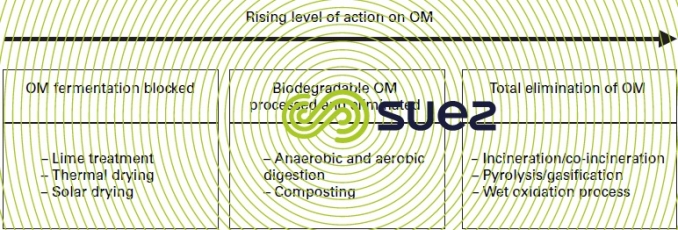liquid sludge stabilisation
Reading time:The term stabilisation must be construed as all processes applied to sludge that makes it possible to:
- either capitalise on the fermentable capacity of the more easily biodegradable compounds so that they can be destroyed, making them easy to store, thus reducing the amounts of sludge to be removed from the plant;
- or inhibit the anaerobic fermentation that emits olfactory compounds and reduce sludge dewaterability.
At the same time, these processes have a more or less thorough sanitisation effect (reducing pathogenic organisms found in sludge).
Therefore, in order to control organic matter fermentation, we need to apply an aerobic biological method (referred to as biological stabilisation or thermophilic aerobic digestion, oran anaerobic biological method (thermophilic or mesophillic anaerobic digestion) to eliminate its easily biodegradable fraction. Ideally, once this organic fraction has been eliminated, any danger that olfactory emanations will be emitted during storage periods, even during a long line and, consequently, anaerobic, will be overcome.
In order to inhibit fermentation that cannot be controlled, we need to inhibit the active micro-organisms present in sludge by altering several parameters: temperature (see «pasteurisation» or thermal drying), pH (treating sludge with lime), water removal (thermal drying, solar drying). These processes all exercise a concomitant action on pathogenic organisms and, therefore, sanitize sludge to a greater or lower extent.
In sludge composting we shall see that composting is a thermophilic aerobic biological process that can be applied to dewatered organic sludge and that is also used to control fermentation and partly sanitize the sludge.
Obviously, if all organic matter is totally eliminated, the residue will be inert: this situation can be obtained with processes such as incineration, pyrolisis/gasification, wet oxidation process (see heat treatment used on dewatered sludge – general comments to organic matter destruction using the wet oxidation method).



Clearly, biological stabilisation is only used on sludge that has a high biodegradable matter content (usually higher than 50 % of DM), i.e.
- sludge delivered from urban wastewater settling or «primary sludge»;
- medium to high loading sludge from aerobic biological treatment (excess activated sludge, trickling filter sludge, sludge produced by washing biofilters) often briefly termed «biological sludge»;
- a combination of the two above sludges or «mixed sludge»;
- low loading sludge produced by aerobic biological treatment without primary settling (excess activated sludge) or «extended aeration sludge».
The term fresh sludge is given to sludge before it is stabilized; the term stabilised sludge or digested sludge to sludge after it has been stabilised. Custom requires the term «digested» to be primarily applied to sludge stabilised using the anaerobic method.
Bookmark tool
Click on the bookmark tool, highlight the last read paragraph to continue your reading later












